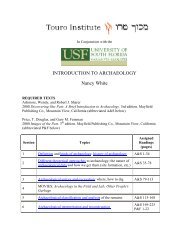In Conjunction with Cultural Anthropology - Touro Institute
In Conjunction with Cultural Anthropology - Touro Institute
In Conjunction with Cultural Anthropology - Touro Institute
You also want an ePaper? Increase the reach of your titles
YUMPU automatically turns print PDFs into web optimized ePapers that Google loves.
8. According to Forest Clements, what are the four common religious explanations for illness.<br />
What social conditions seem to make each more likely?<br />
9.What are the four stages of a religious revitalization movement?<br />
10. <strong>In</strong> Guthrie's view, what do concepts of gods, spirits, and mana all have in common?<br />
Reading Assignment: Chapter 7: Aesthetics and Culture<br />
<strong>In</strong> this assignment you will learn the principles that describe cultural change. You will become<br />
acquainted <strong>with</strong> the four major stages of cultural evolution, archaeological evidence for the<br />
evolution of cultures, and the laws that govern cultural evolution.<br />
Assignment Overview<br />
MCQ :: Matching :: True/False :: Short Essay<br />
MCQ - Chapter 7: Aesthetics and Culture<br />
1. <strong>In</strong> non-literate societies, art is:<br />
a. not always a specialized sphere of life.<br />
b. the domain of specialists.<br />
c. clearly distinguished and set apart from utilitarian life.<br />
d. restricted to song and dance.<br />
2. Aesthetic locus is:<br />
a. the technical term for art and artistic standards.<br />
b. the technical term for the objects to which a society devotes particular artistic emphasis.<br />
c. any place such as a theater or dance ground where artistic performances occur.<br />
d. any feature of the natural environment that people regard as particularly beautiful.<br />
3. Which of the following is NOT a necessary characteristic of art?<br />
a. It is the product of an individual artist.<br />
b. It conveys symbolic messages.<br />
c. It uses both universal signs and culturally specific symbols.<br />
d. It expresses feelings.<br />
4. <strong>In</strong> Hindu aesthetics, the central feature of good art is:<br />
a. its ability to convey a subtle intellectual concept.<br />
b. its ability to convey a moral message.<br />
c. its ability to give sensuous pleasure that is equated <strong>with</strong> oneness <strong>with</strong> the divine.<br />
d. its ability to support religious beliefs.
















